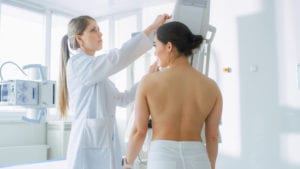
3D mammography is an effective type of imaging test that combines multiple breast X-rays to create a three-dimensional picture of the breast. This type of imaging tool is used to look for breast cancer in women who may or may not be experiencing obvious warning signs, and it is particularly beneficial for women with dense breast tissue.
Breast tissue is made up of specialized glandular tissue (lobules) and ducts that produce milk, supportive fibrous tissue, as well as fatty tissue. Breast tissue may be referred to as dense if there is a lot of fibrous or glandular tissue and little fatty tissue. Dense breast tissue can make it more difficult for a traditional mammogram to see through the entire breast and to identify small tumors in or around the dense tissue.
Regular breast examinations and mammograms are a vital way to help women detect any changes or abnormalities in their breasts, thereby allowing them access to appropriate medical care and treatment as soon as possible, if necessary. A 3D Mammogram (also known as breast tomosynthesis), is a safe and highly effective imaging procedure that combines multiple breast X-rays to create a detailed image of the breast.
Clearer Images
Although 3D mammography is similar to a traditional mammogram, a 3D mammogram takes multiple images of the breast at varying layers, whereas traditional mammography obtains a single image. 3D mammography provides a more revealing analysis by producing clearer and more detailed images of the underlying breast tissue, which can help to identify potential abnormalities and growths at the early stages.
The images that are collected during a 3D mammogram are amalgamated by a computer to form a clear 3D picture of the breast. The 3D mammogram images can be examined as a whole or in smaller sections for greater detail. The machine also creates standard 2D mammogram images to give a more complete breast cancer screening analysis.
Greater Accuracy
3D mammograms are beneficial for women with dense breast tissue, particularly those who may be experiencing warning signs of breast cancer, such as a mass, breast pain, or nipple discharge. In 2D mammograms, tumors appear dense and white – but dense breast tissue can also appear this way, obscuring a potential growth and making it more difficult to detect signs of unusual cellular growth. 3D mammograms create many images at various layers, which ensures more accurate results and makes it easier for the physician to identify a tumor and see beyond areas of density.
Reduces False Positive Results
Using 3D mammography not only makes it easier to catch breast cancer early, it can also help doctors to see the cancer size much better than using a 2D mammogram alone. Clearer images reduce the chances of doctors seeing a false positive (an abnormal area that looks cancerous but is in fact normal).
Research has also shown that staggering 3D mammography with standard two-dimensional mammograms can improve breast cancer detection and reduce the need for follow-up imaging due to false positive results.
Low Risk Procedure
A mammogram uses X-rays to create an image of the breast, exposing the patient to a low level of radiation. However, it releases the same amount of radiation as a traditional 2D mammogram, making it of no greater risk to the patient.
3D Mammography in Bronx, NY
At Starling Diagnostics, we offer state-of-the-art diagnostic services provided by our team of highly skilled, board-certified radiologists who are equipped with the latest advanced technology. If you would like to learn more about 3D mammography, including how to prepare for this outpatient procedure, call Starling Diagnostics at (718) 319-1610 or you can schedule an appointment using our convenient and secure online request form.
